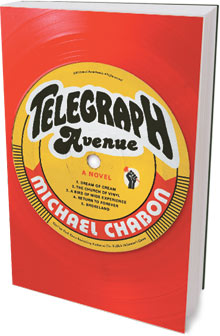Michael Chabon has a thing for pop culture. From comic books (The Amazing Adventures of Kavalier & Clay) to Sherlock Holmes (The Final Solution), he's taken our collective pulse through our amusements. In Telegraph Avenue, his first novel in five years, the objects of obsession are vinyl records, specifically of the '70s funk hybrid known as "soul jazz," beloved by his record-store-owning protagonists Archy Stallings and Nat Jaffe. But he — and they — are just as smitten with such other late-20th-century artifacts as blaxploitation films, muscle cars, and kung fu, all of which come into play as the two negotiate the twisted fortunes of relationships (both familial and romantic) and retail in Oakland, California, in the fall of 2004. The result, as fans could expect, is chock-full of detail and humor.
Sometimes too full: Telegraph Avenue is Chabon's most dense delivery yet. At its peak — and that's often — Chabon's abundant wordplay is exuberant and joyous. The "dream of cream," the childhood treat for which the book's first section is named, for example, is recalled as a "crumbly chocolate cake interglaciating floes and tundras of whipped cream, the outside armored in a jagged tectonics of wide chocolate shavings." It's an indulgent description of an indulgence, maybe a tad too rich. And that's before an aspiring senatorial candidate named Obama appears.
 |
"Partly that's my natural gait," says Chabon by phone regarding the ornate swing of his sentences. "And also I was working with this background of music — of jazz — so there was a sinuousness and a flow. I also listened to so much hip-hop when I was working on this book, and I've always been drawn to the MCs with flow — Rakim and Big Daddy Kane and the guys in Organized Konfusion — that was an inspiration to me, so I think with a lot of these sentences I was experiencing that sense of flow."Here’s more of Clea Simon’s conversation with Michael Chabon:
POP CULTURE PLAYS SUCH A BIG ROLE IN YOUR BOOKS. WOULD YOU TELL US WHY?
It is culture, it’s a part of culture. Yesterday’s pop culture is today’s high art. Look at Italian opera. The distinctions are so slippery and temporary, intellectually and emotionally. I was raised by a father who loved Bartók and Star Trek, and he loved them equally and as passionately and each of these made him happy. The aesthetic criteria is pleasure, and that’s what I hold to today.
In Telegraph Avenue, there are all kinds of [high culture] allusions. They just don’t draw as much attention to themselves, because they’re familiar. That may be why it’s appealing to draw imagery and metaphor from aspects of popular culture – science fiction films and comic books – they haven’t been used as much as references to classical Greek mythology, the more traditional sources of literary allusion. I use imagery from Abraham and Isaac, Jacob wrestling with the angel, that material remains every bit as potent and powerful, but I feel there’s this whole other playing field. The roster I can call onto the field that is less trafficked and is therefore a little more surprising – and so maybe the reader will pay a little more attention.